It’s been 3 months since my exploration of an unusual haikyo house ignited a whole heap of discussion. Since then, several major haikyoists have figured out the location and documented the site, and the shrewd people over on 2ch have been slowly picking away at the mystery surrounding the family. But with the the location recently disclosed, I had to make haste to gather the final pieces of the puzzle…
(Reads parts 1, 2, 3 and 4 here first).
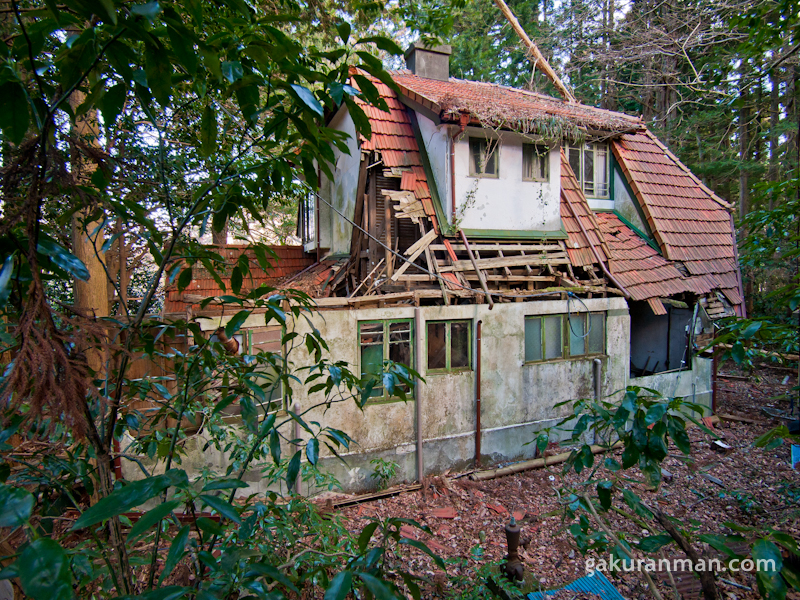
It was just a few days ago. Somebody violated the unwritten haikyo law that one should never post links to maps or give out obvious details about a location. This is especially so for places like the Royal House haikyo, which contains a treasure-trove of old, historical artefacts and personal items left behind. I always knew that it was just a matter of time before somebody leaked the place, but I didn’t expect it to come in such an audacious way… So with time now against me, I decided to visit the house one last time, seek out any remaining evidence and try to solve this mystery once and for all.
Chasing Down the Ghosts of the Past
The first break came through from my pal Jordy over at Meow.fr. He had been busy piecing together his own version of events. With the help of a Japanese friend of his, he figured out the location to the temple where the K family were buried. Not content with just snapping some photos of the family grave, he also talked to the temple priest and got some extremely valuable information about the family that we’d been lacking so far. Not one to be left behind, I wanted to visit the temple myself and talk to the same priest to hear the story, so I shot off to Tokyo almost immediately.

I first visited the family grave where both Sugiko and John are buried in order to pay my respects. It was almost surreal to find it after all the research and exploration. People I never knew personally but now know so much about and their colourful lives. It felt strange, but oddly, the right thing to do. After placing a coin on the stone in front, I went to talk to the priest.
They were very surprised at my visit (almost mistaking me for the same Jordy visiting again!) but I managed to break down their initial barriers and we got to talking. I took a leaf out of Crime Reporter Jake Adelstein‘s book and thanked them for their time with a small gift; building trust and good relationships with people is key to being a good reporter. I only gave them some strawberries I bought locally, but everything went well and it was fantastic to make my first real attempt at journalism.
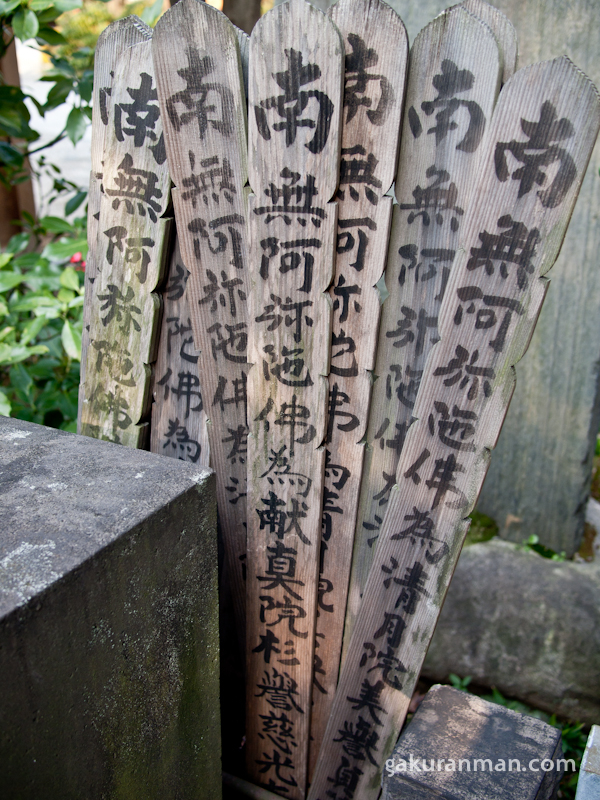
First I discussed the family with the son of the temple priest. He was initially nervous (and rightly so), but with some small talk and showing my enthusiasm (as well as the book about the Foundation that I had procured), he agreed to help. Afterwards I got to chat with the chief priest himself (住職) who knew the family well. He was able to give me dates for the deaths of a couple of members in the family as well as some invaluable back-story to Hotel Okura, two of the sisters and the old house itself. Together, we developed a hypothesis as to why the countryside retreat may have become abandoned and also a potential explanation about the curious final words made by the original finder of this haikyo – Kaede-san. If you recall, he said he “felt that I’d learned something I’d prefer not to have known.” What could this be..?
But we’re getting ahead of ourselves here! Let’s start by clearing up some of the doubt and getting a few facts straight.
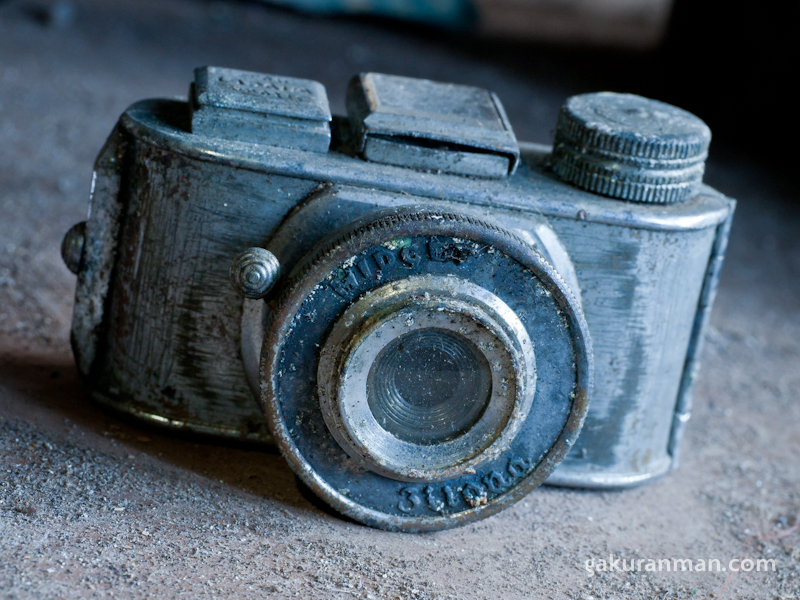
The Children
According to the chief priest, there were 5 children in the K family. The eldest brother Junji, the eldest sister Kiyomi and Sugiko are sure facts. The other two are still a little vague – there is another younger sister, possibly Kiyoko (but I can only guess from a name I found on other postcards in the house) and also a younger son (Masahiro) who died at a very young age. Those following the mystery on 2ch put his age to be 4 years old and there are plaques and other materials that support the idea that the family lost a young son.
Sugiko as we know married John, the millionaire pearl dealer from the U.K who established his own business and huge charitable foundation that still exists today.
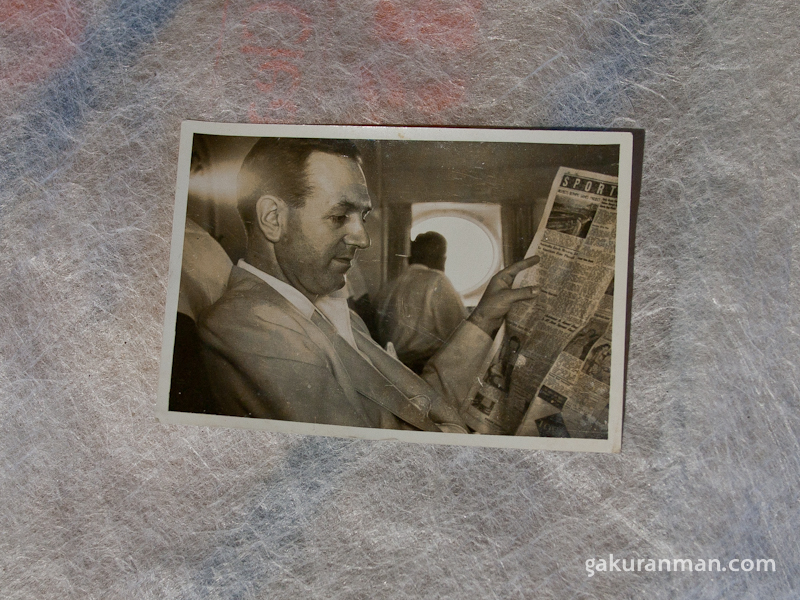
(Above: Sugiko’s husband John)
He lived his life with her in Tokyo, in a house very close to the Hotel Okura. They were frequent visitors of the hotel so much so that the hotel staff often asked them for help and advice on how to best treat foreign guests.
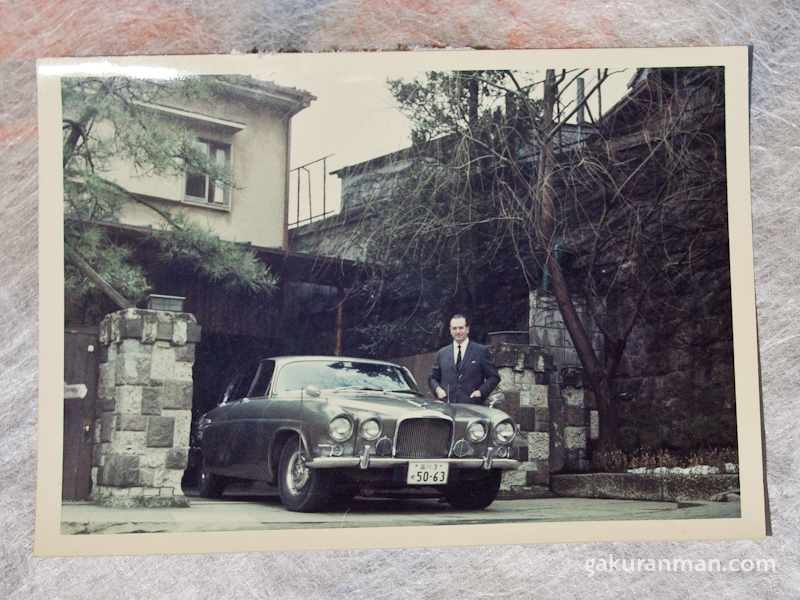
(Above: John at his Tokyo abode)
Sugiko herself was a regular patron at the Hotel and spent almost all of her time there in the later years. She was known as Mrs. J (her surname changing after marriage) – something which is documented on a blog written by an ex-member of staff. According to the chief priest, she received monthly payments from John as much as 2,000,000 yen (about 20,000 pounds on the old exchange rate of 1 pound to 200 yen). One blank cheque found in the house from John – although not written to Sugiko – shows just how wealthy he was.
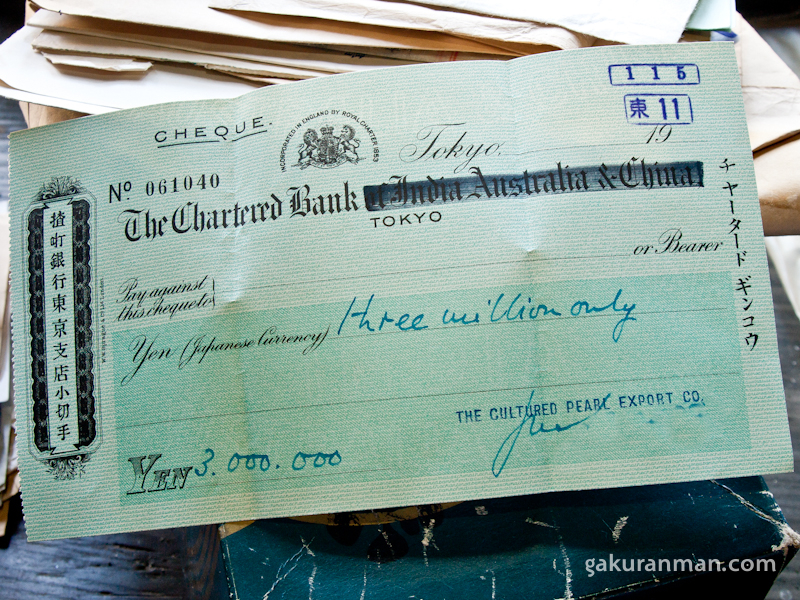
She was well loved by the staff at Hotel Okura and also well cared for by John, who everyone I have spoken to has said was a generous and very kind person.
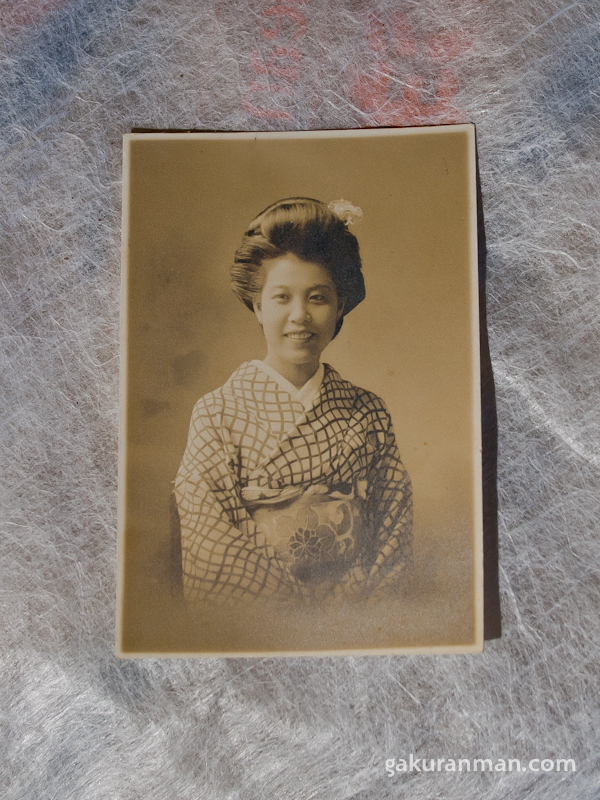
(Above: A young Sugiko)
I visited the Hotel Okura myself to ask a few questions. According to staff, it seems that Sugiko spent a lot of her time there, so it is reasonable to assume that she did not travel everywhere with John and perhaps had periods of time alone. But with photos of the numerous parties she attended, I think she probably enjoyed her luxurious life. Temple documents note that Sugiko died 19th November 1997, aged 78 years (born 1919).

I had inklings about Sugiko and John, but knew nothing about other members of the family. It turns out that Junji, the man with the stylish round glasses is not the father of the family – he is the eldest brother. I had completely assumed that he was the dad judging from his older appearance, but both the chief priest’s story and letters sent from Sugiko to Junji’s address at the house bearing the title 兄上様 confirm that he was indeed the older brother.
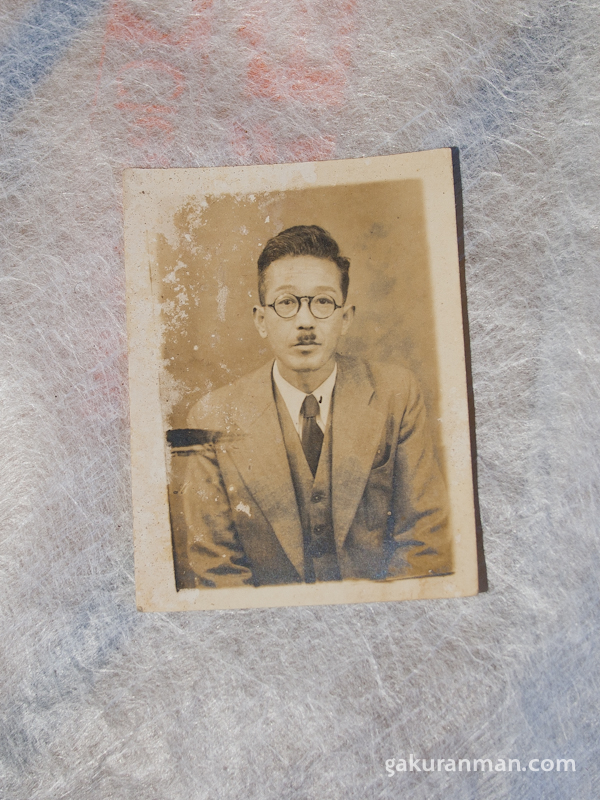
(Above: Junji wearing his distinctive glasses)
So we know that he lived at the house, but how do we know that Junji is the man with the distinctive glasses? There are at least two clues. In the house, there is a suit hanging up in the back bedroom with the K family surname sewn into the inner pocket. Also, there is a box containing the very glasses that we see him wearing in so many of the photos. It is not hard evidence, but with all the supporting pieces, it seems highly likely. I did not get a date from the chief priest on Junji’s death, but the observant Mr. 252 on 2ch who visited the house claims he found a memorial speech from the funeral dating it to be 1982.

It is unclear what Junji did for work, but a picture including him with a group of men and women wearing business suits and a postcard addressed to him from Hatoyama Ichiro (ex Prime Minister of Japan) suggest he was important. Interestingly, the postcard I found is different to the one Ruins Rider found on his visit.
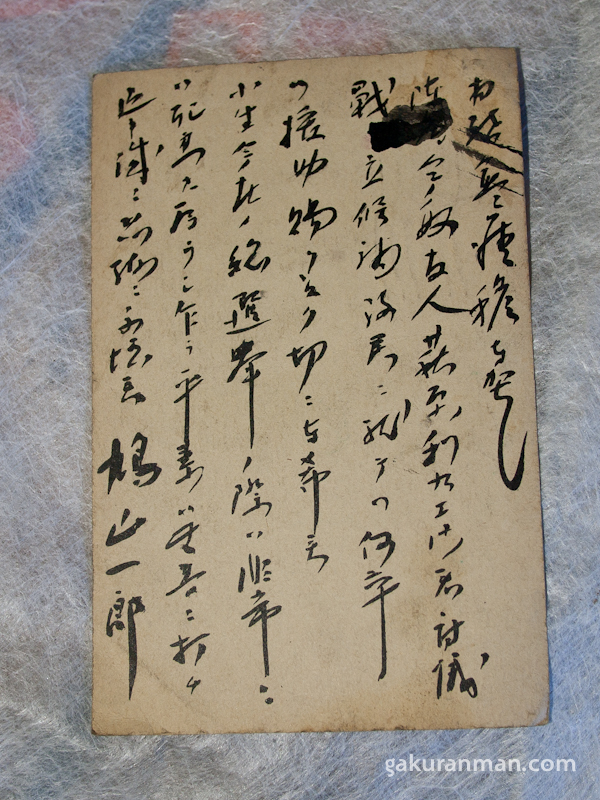
Next then, Kiyomi. According to the chief priest, Kiyomi lived together with her brother at the house (letters addressed to both siblings can be found inside) and both remained unmarried their entire lives. Kiyomi wore kimonos very often and, as it turns out, she was the older sister of the family. I had originally been thinking that Sugiko was the eldest, but the two dates I acquired from the temple confirm otherwise; Kiyomi passed away on 22nd November 2003, aged 91 years (born 1912 – 7 years before Sugiko). But how to tell her apart in the pictures..? There are a couple of clues I’ve found that suggest she is the elder looking lady whom I originally thought might be the family’s mother.
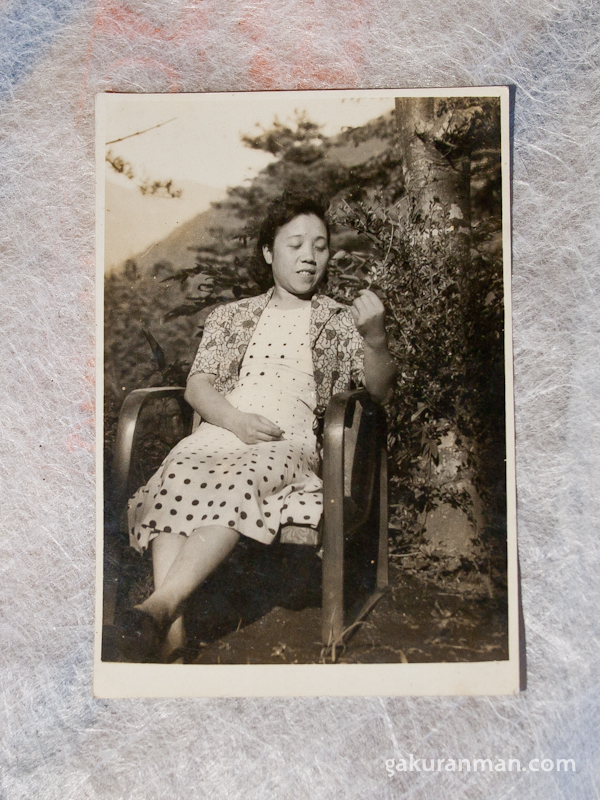
(Above: Kiyomi, aged 36 years)
How can this be?? Surely the younger looking lady in the dinner party pictures is Kiyomi? It seems not. Flipping the photograph over, we can read this:
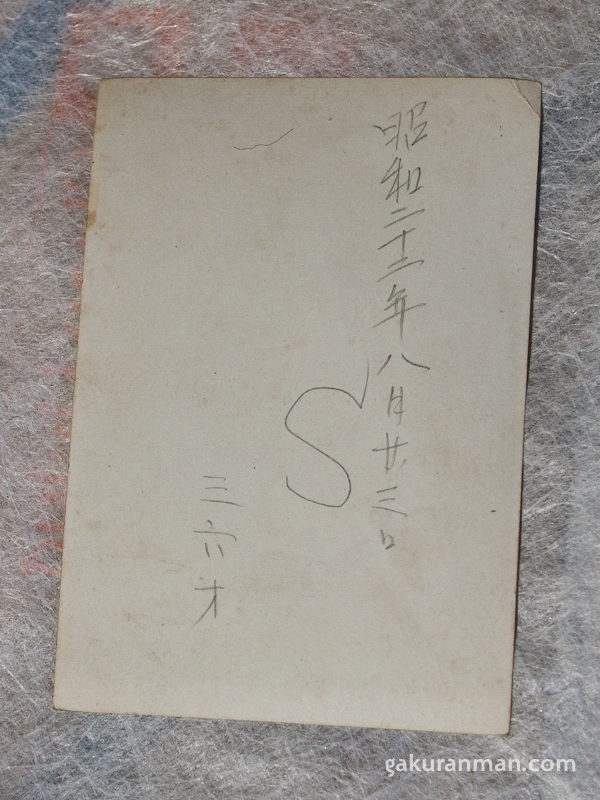
The date reads: 13th August 1947 and the age – 36. This exactly matches Kiyomi’s birth date. Furthermore, if we look at pictures from Sugiko and Kiyomi’s last years, we find that the lady in the picture above matches an elderly Kiyomi.
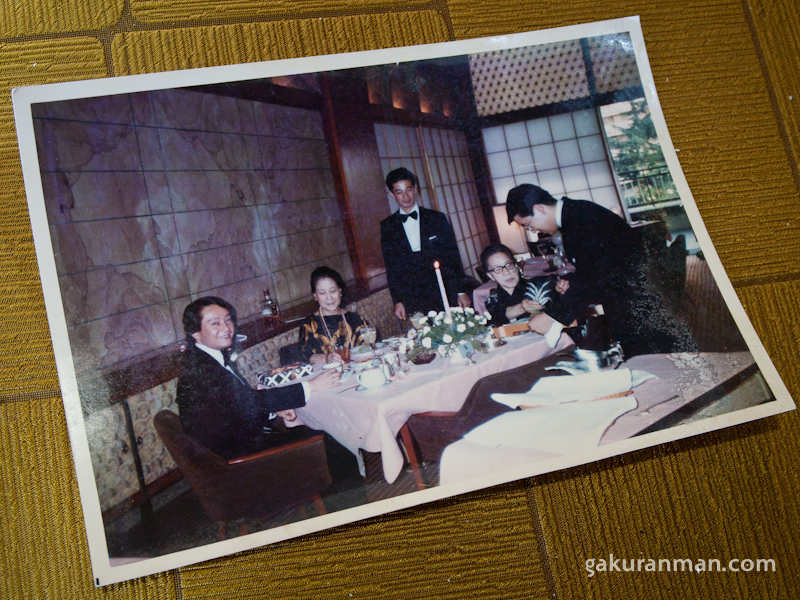
(Above: Sugiko and Kiyomi in their final years at Hotel Okura)
The chief priest tells me that Kiyomi lived at the hotel too, but only in the last years of her life after John had passed away in New York in 1991. (According to the priest’s wife, John died from a heart attack as he was exiting a swimming pool.) It seems to be the case that she was alone after her brother has passed away, and with Sugiko a widow, the two spent their last years together on floor 2 of Hotel Okura. Letters posted to Kiyomi at the Hotel Okura confirm this.
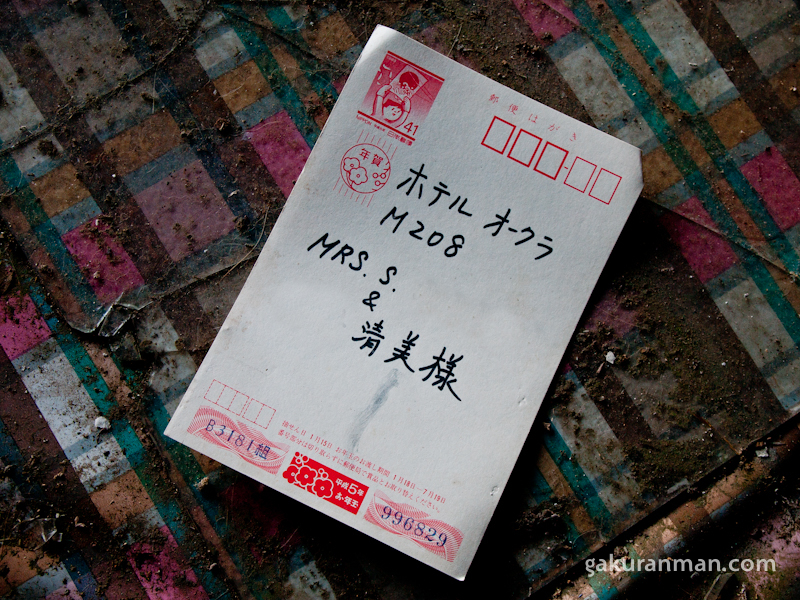
After Kiyomi’s death, her belongings were sent back to the house and remain there, piled up by the front door. Old letters and photos, as well as a rather shocking sight hidden amongst them. I suppose the hotel did have to send *everything* back…
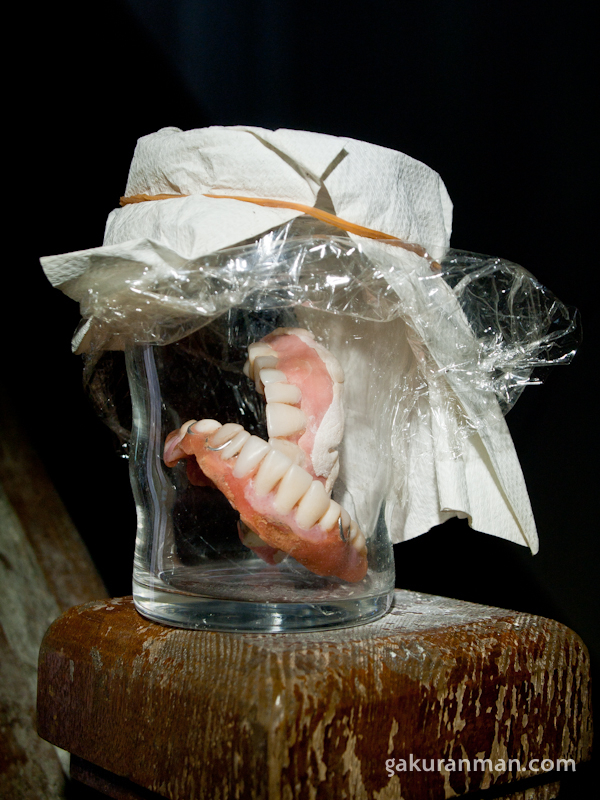
So what then of the two remaining siblings? The younger brother is perhaps the easier of the two to work out. Masahiro died very young (the cause of which I do not yet know). We can find a small plaque in the house bearing his name as well as funeral documents and photos of a baby. In the picture below, Kiyomi is holding the child I believe to be Masahiro. It is the same child whose picture is in the alcove along with other deceased members of the family.

(Above: Kiyomi and Masahiro)
Interestingly, neither Sugiko nor Kiyomi’s pictures are displayed in the alcove although their brother Junji’s picture is. But this makes sense when we think about the order in which they died – Junji passed away first and then Kiyomi went to live with Sugiko at Hotel Okura around the time John passed away. Presumably Kiyomi in her old age was not maintaining the countryside house or the family pictures in the alcove. Remember, too, that the date on a calendar in the house read 1988 – after Junji’s death but before John and Sugiko’s passing. It seems reasonable to assume that Kiyomi was still living in the house after Junji’s death in 1982 but not when Sugiko passed away.
The final child is still somewhat of a mystery to me. I have no solid names, but Kiyoko seems to be a possibility. There were postcards in the house addressed to her living in Tokyo.
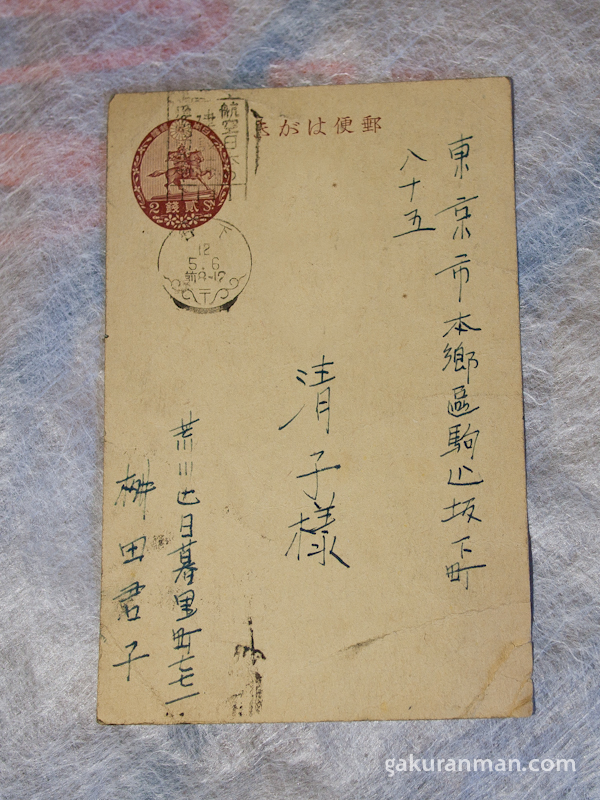
The chief priest did give me some very interesting information about her however. It seems that she married and changed her name to match her husband’s – the N family. It is possible that she may still be living, considering that she was the youngest sister, but neither I nor the temple have any dates to hand. Because she married into another family, her records are no longer with the K family temple. The chief priest also tells me that no-one from the K family has visited the temple for years, which leads me to think that there are no relatives living with the K family name.
One picture did catch my attention though. The people on 2ch again surprised me with a fantastic observation – a woman at one of Hotel Okura’s parties is wearing a wedding ring! It is probably not Kiyomi because the chief priest told me that she never married (although we cannot rule out his being mistaken), so might it perhaps be the missing sister Kiyoko? And is that her husband standing behind her..?
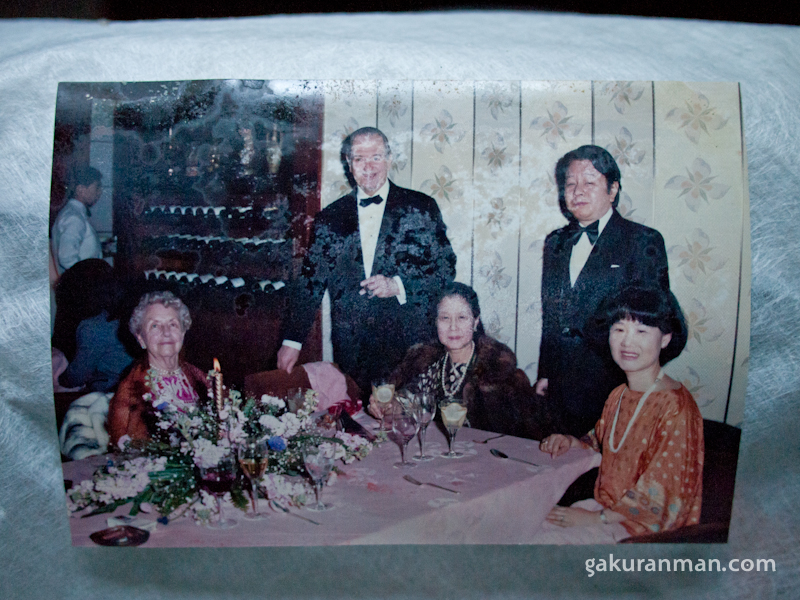
(Above-right: Possibly Kiyoko and her husband..?)
The chief priest offered to try and dig out her phone number for me, but they were pressed for time and I wasn’t sure she would appreciate people asking questions. She would certainly have known about the house her siblings lived in and must have her reasons for not visiting or maintaining it. Apparently at one point somebody tried to sell the countryside house, but for various reasons unknown, it did not go well. Mrs. N is certainly a potential route for inquiry though…
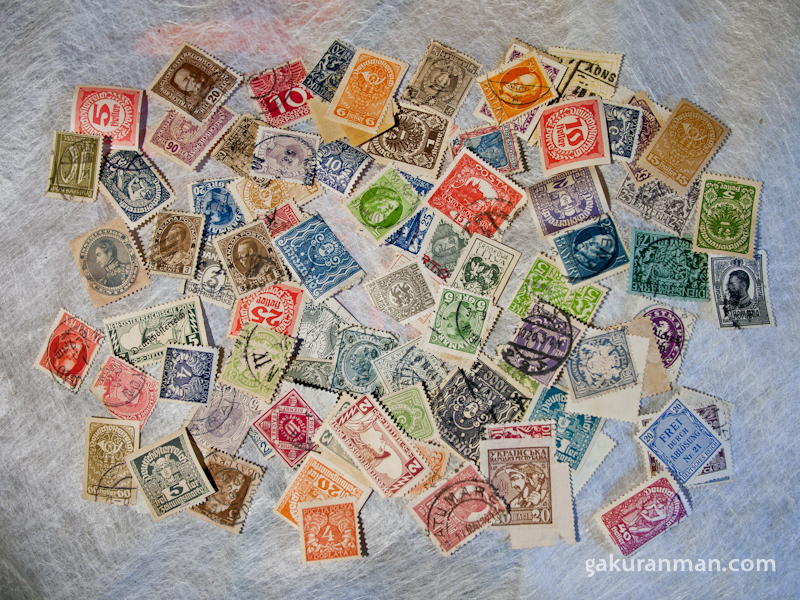
The Parents
By answering some questions, we open the door to many more. Although we have figured out most of the main details regarding the children, their parents – and especially the father figure – remain elusive. That isn’t to say that there are no leads however, but they are still hazy. Let’s take a look.
Upon asking the chief priest about the K family parents, he regrettably told me that he knows very little about them. However, another name found in the house – Kuwa – is interesting. The postcards bearing her name are much older.
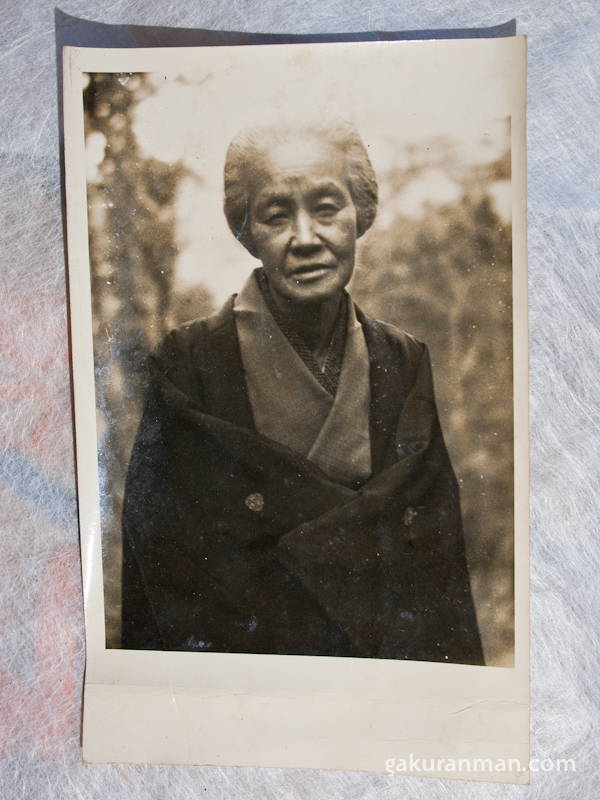
(Above: Kuwa, the mother of the family)
I couldn’t make much sense of it while in the house, but once again Mr. 252 from 2ch came through with gold:
252 :以下、VIPにかわりましてパー速民がお送りします [sage]:2011/01/29(土) 21:29:51.00 ID:CiegDfmx0
まず、肖像画のお婆さんの名前はひらがなで「く○」さんです。蚕のエサと同じ読みです。昭和40年に亡くなっています。同年11月6日に77日忌が淳○さ ん喪主で行われました。これは弔辞が残っていたのでそれで確認しました。あの肖像画は日付(細かいところはよく読めないが昭和40年?)から言って亡く なったころに描かれたものと言えそうです。同サイズの複製画もありましたので親族に配ったのかもしれません。ちなみに親族関係は淳○さんの母です。また、 ママさんとS子さんの葉書にあった呼び名、それはこのお婆さん、即ち「く○」さんです。
To summarise, Kuwa died in 1965 (we can tell this from a message of condolence found in the house). Junji held the ceremony in the same year on 6th November for Kuwa, his mother. It is the same woman who is in the painting, likely created during the last years of her life.
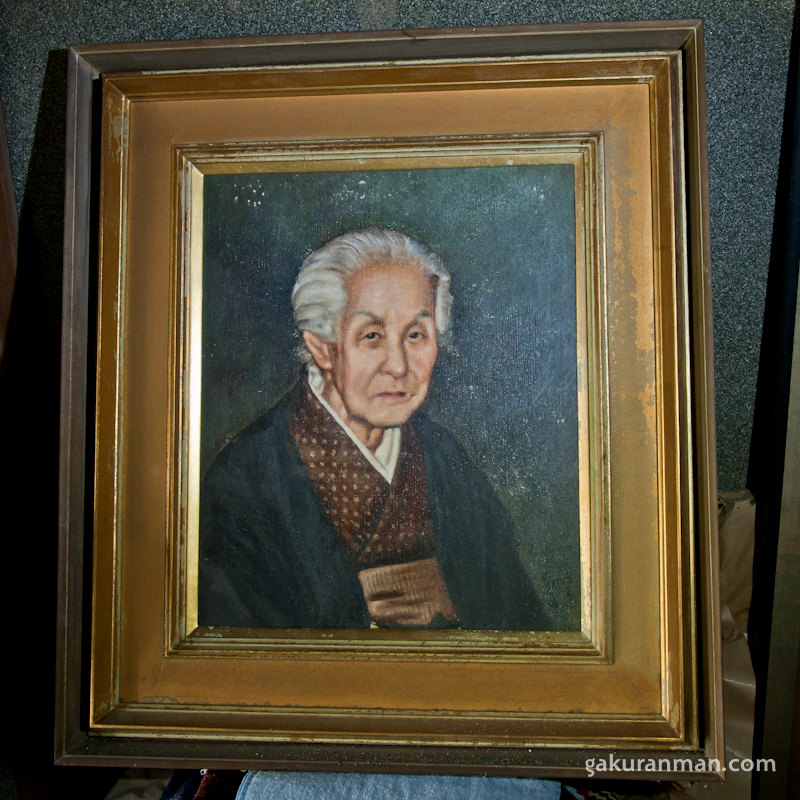
There were actually two paintings in the house – perhaps the other was to be sent to relatives. I also found a postcard in the house written by Sugiko in 1960 reading ‘Mother’. Combined with other pictures of the old lady around the countryside retreat, it seems that she may have lived in the house with her children at some point.
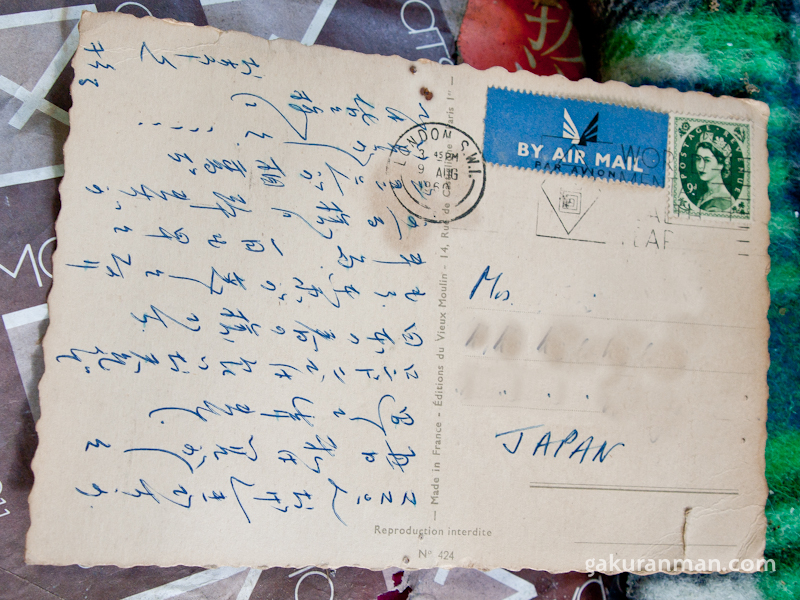
Currently, there isn’t much more information than that. Hopefully we’ll see additions in the future.
The father, now this is a real mystery. Especially so when I found this shocking photograph hidden away in a box:
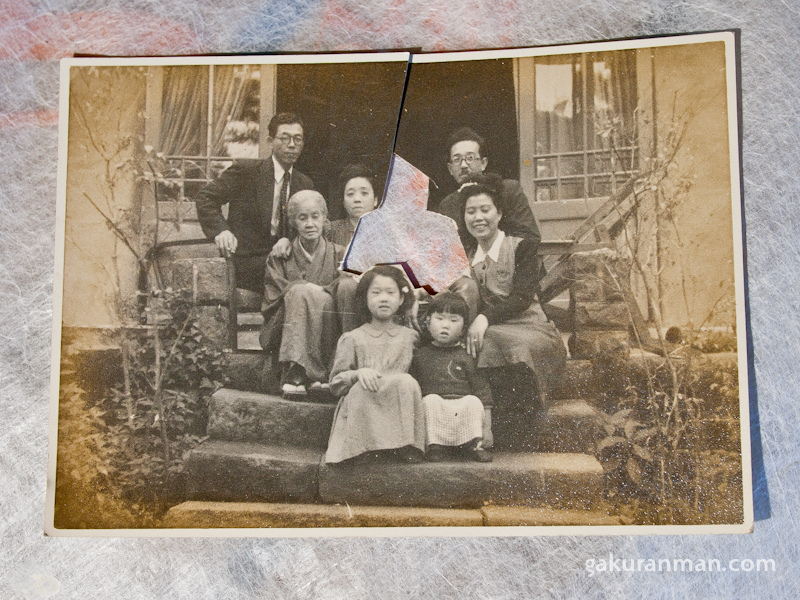
Here we see the family: Sugiko on the right, Junji behind her, Kiyomi on the left with a mystery man behind. Kuwa is sitting next to the figure who is missing from the photo and two mystery children are in front. There were a couple of other pictures with a person cut out as well. I can only assume from the position in the picture that it is the father. Or could it be John..? What happened that caused someone to butcher these photos? And who cut the person out? Kiyomi or Junji? Perhaps even Kuwa when she lived in the house..?
Information on the father is extremely limited, so I must continue with mere guesswork, but a couple of pictures struck me. Below the family seem to be enjoying themselves on the beach.
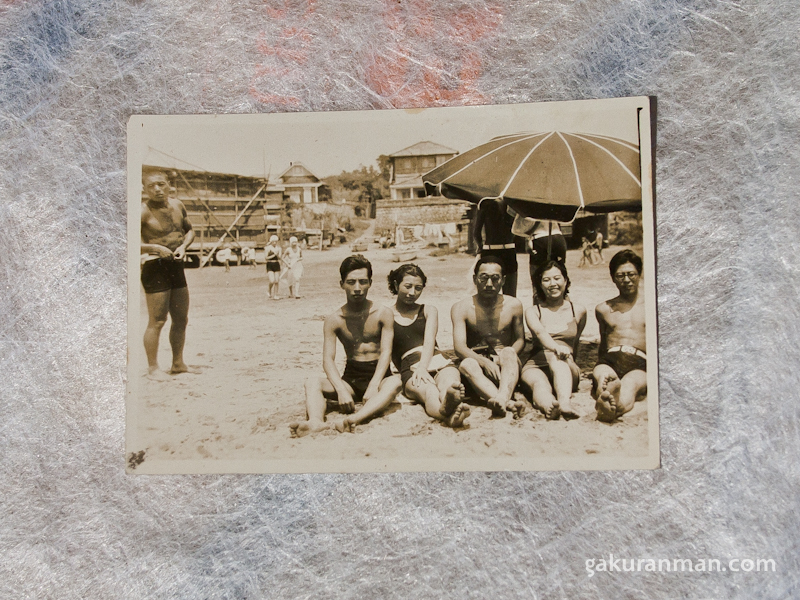
Another very old picture shows what looks to be the same man on a horse:
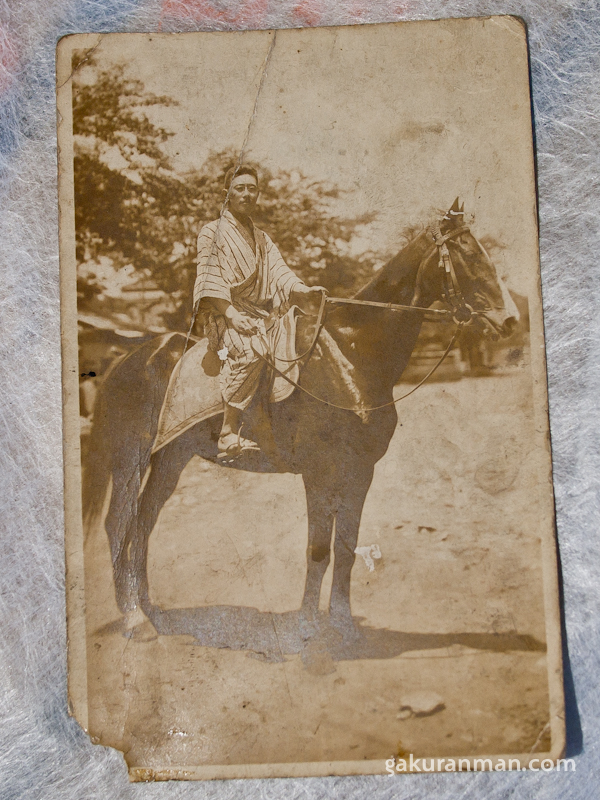
My research has led me to believe that the father’s name is Masaki and that he was involved in the cinema world. There were many postcards in the house addressed to this man and a business card below. He was the proprietor of a cinema in Tokyo and involved in many other activities. Whether or not the man above is Masaki or even the father of the family is unknown, but it’s my best guess so far, assuming the other information about the 5 children and lack of marriages is correct.
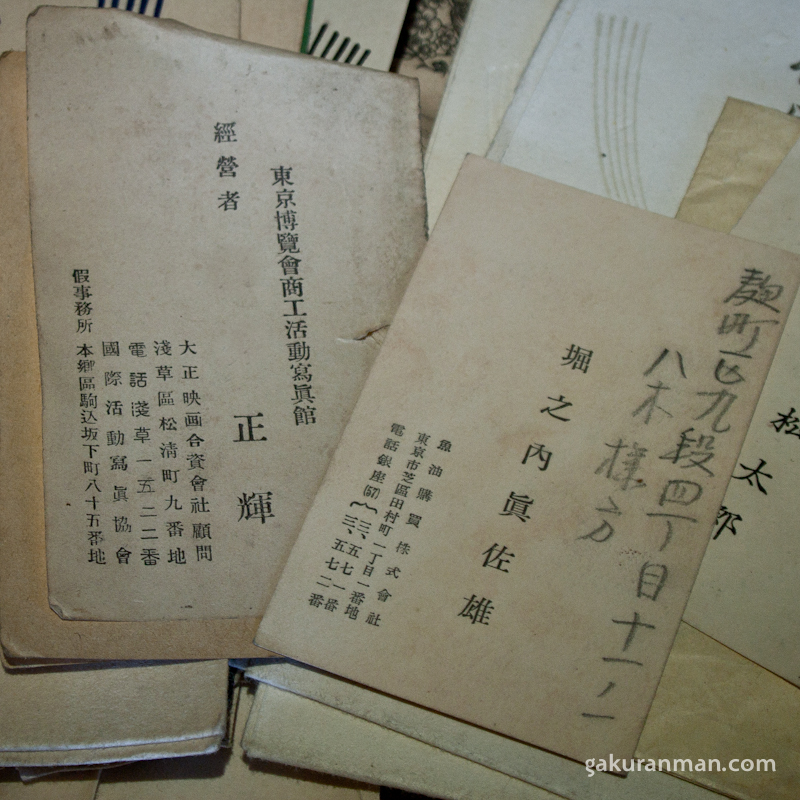
There are a few more interesting photos that I cannot place, but that may be of use to other people trying to piece things together. I’ve included them for reference.
The mysterious picture shows four gentlemen, one of which is a member of the K family, aged 26. Is it Junji perhaps..?
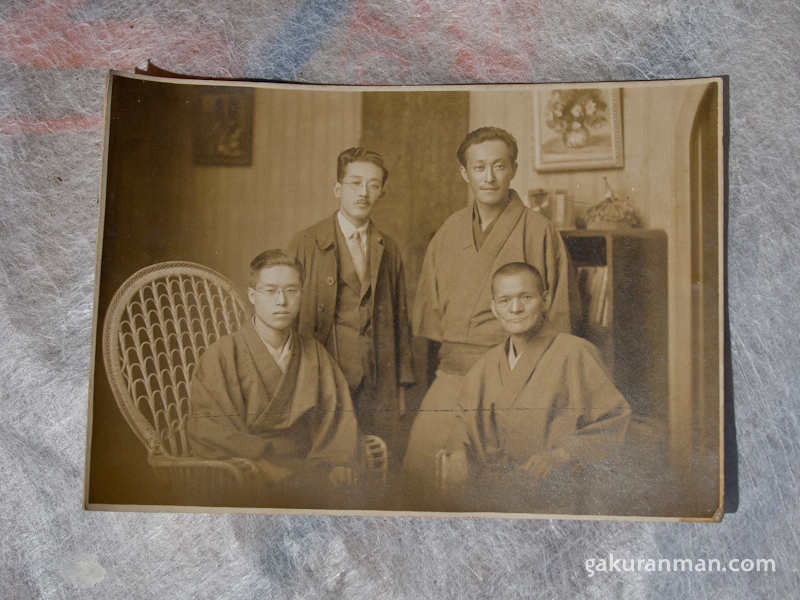
Another item found amongst the photos. Perhaps a friend of the family? He looks an awful lot like Junji though, but the name is different…
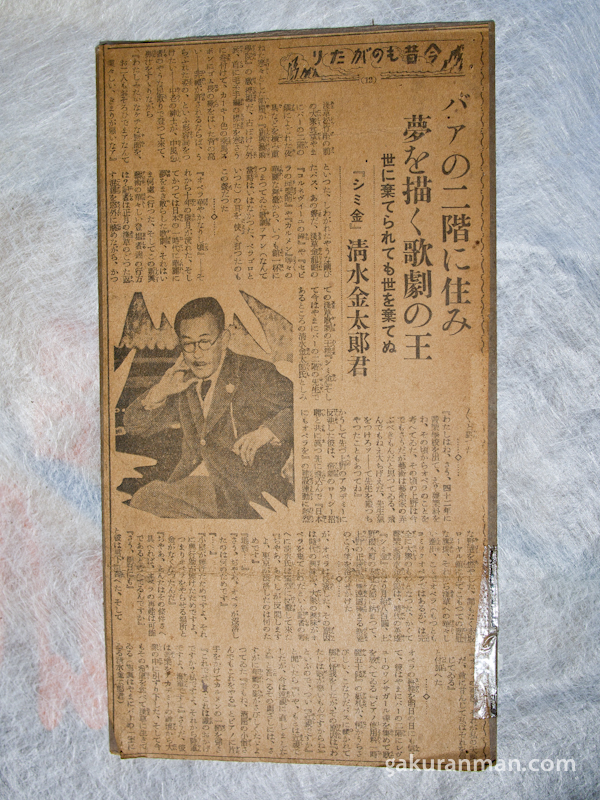
There’s also this picture, which may show Torinosuke, a possible son of the family sitting with Junji. Or perhaps he is Junji’s son? I can only go by the information the temple gave me, which was that Junji never married and there were 5 children in the family. Perhaps Junji had a son outside of marriage? Perhaps the chief priest’s information is wrong? I have no idea.
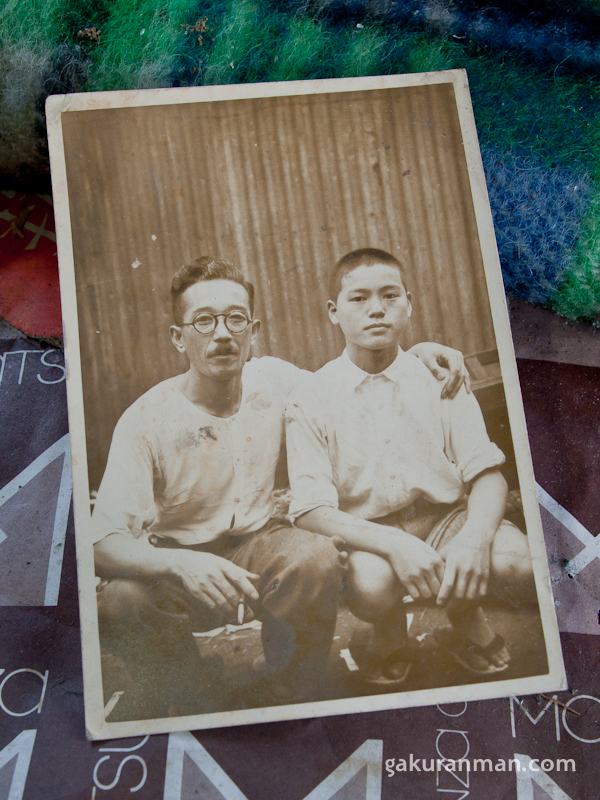
(Above: Junji and possibly Torinosuke?)
That about sums up the information I’ve been able to gather about the family John married into. There are still gaping holes and plenty of unconfirmed things, but the story now feels a lot fuller than it did a few short weeks ago. But still, what happened at the end..?
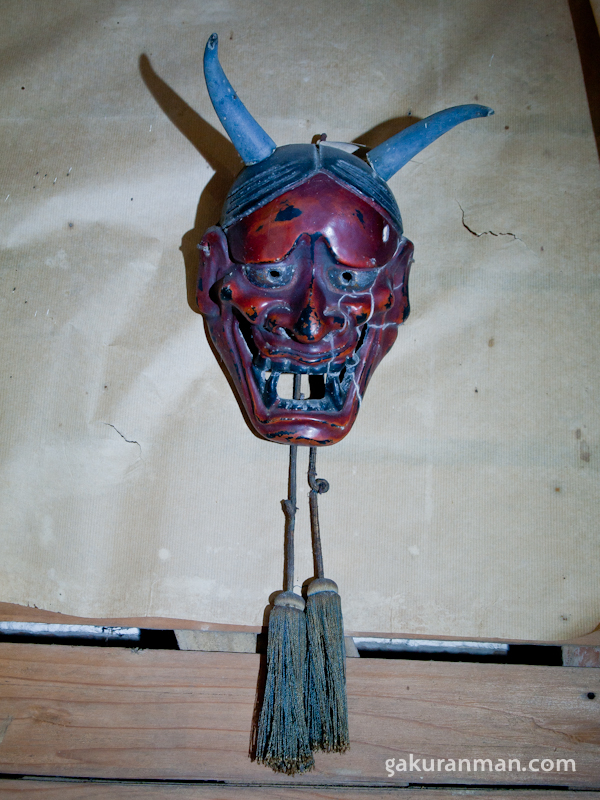
Potential Leads
**Update** 2011/02/03
Browsing through my photos and reading the latest ideas on 2ch, I came across something rather striking. In a large majority of the photos, a particular couple always appear together. The pictures range from funeral photos to parties and both the man and woman can be found in separate pictures. I wonder, could this be the missing daughter (Kiyoko, perhaps?) who married into the N family? (Click on the image to see it full size).
But wait, there’s more! I also found 2 references of the N family name that the chief priest had told me! Both are in funeral pictures, including one picture in the collection above which has a couple who look very similar to the other pictures. Perhaps this is the N family? The N family name plaque is also very close to the altar – the same proximity as John’s who we know married a daughter of the K family. If we follow that logic, the N family plaque must be important and close to the altar for similar reasons.
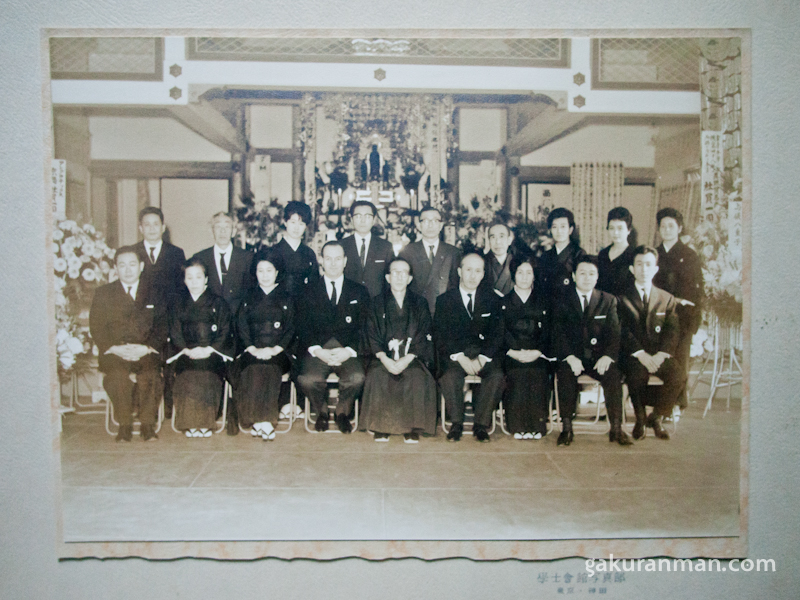
The large version of the funeral photograph (Junji’s funeral, perhaps?)
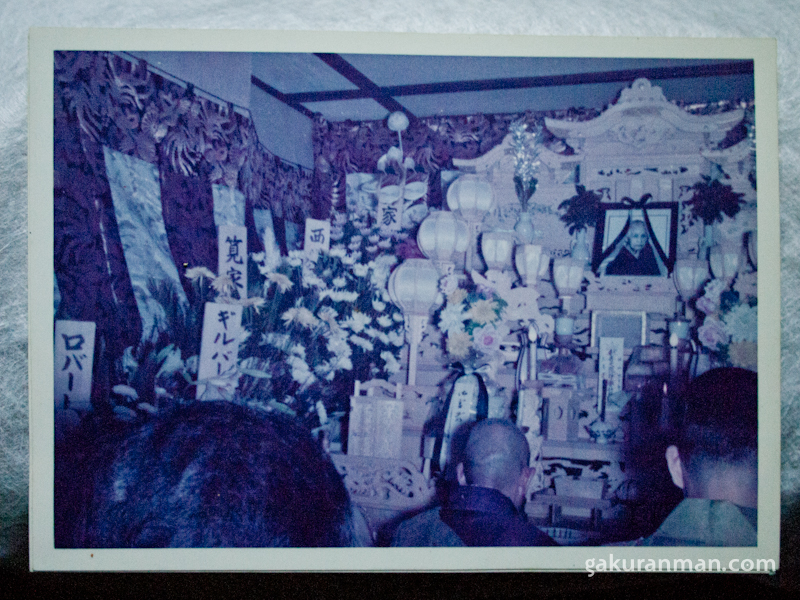
Above is Kuwa’s funeral. We can clearly see the start of the N family name on a plaque (I have removed one of the characters). The second character is the same as the first in the K family name.
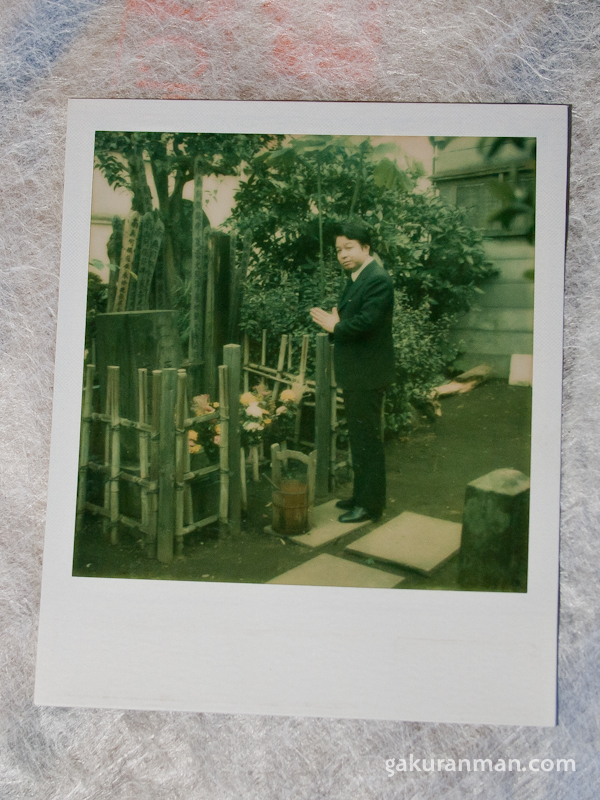
Another photograph of the same man visiting the family grave.
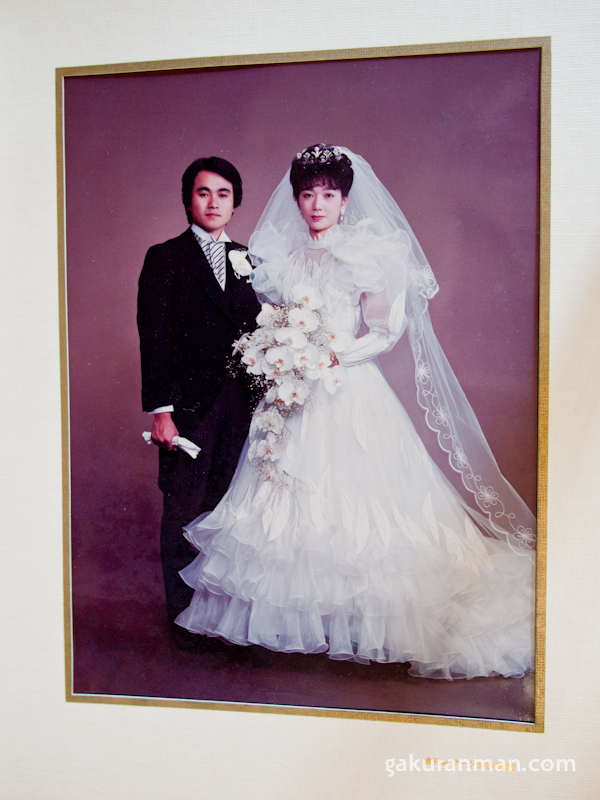
The shot above shows the couple on their wedding day – a photograph from Hotel Okura.
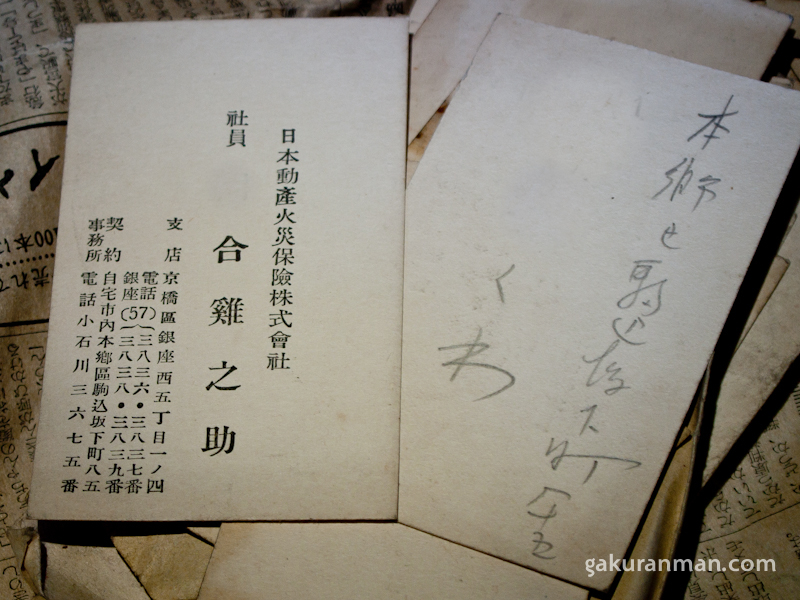
Finally, a business card bearing Torinosuke’s name. Interestingly, the second character is different from the K family name, although it has the same reading! If this were a letter, I would assume it had been mis-written. But this is a business card – surely there would not be a mistake..? Also, the first character of the first name is slightly different to what I have seen on other sites. Perhaps this is a different person altogether..? It seems to close to be coincidence though. So what does this mean? Is Torinosuke not a family of the K family after all? Or did the K family name change at some point?
A Theory
So why did the house become abandoned and end up as it has? Nothing is perfectly clear, but my theory is this: Sugiko received monthly payments from John who in turn, shared the money with her family. As far as I have learnt, Kiyomi did not work and with her brother having passed away in 1982, she would have had to finance her house somehow. I think that money from Sugiko was, at least in part, used for this. After John died, Sugiko likely still received payments as his wife. Kiyomi moved to Hotel Okura in her old age and also to keep her sister company, but after Sugiko passed away in 1997, Kiyomi was left without a source of income, and could not easily finance the countryside house nor afford to stay in luxury at Hotel Okura. She was forced to go and live in an old-person’s home during her last years.
This – and the death of the younger brother – seems to me to be the tragedy in the K family life; a sudden fall from luxury due to the death of their benefactor and kind in-law, John. This is of course my own hypothesis and not a fact, but with the story told to me by the chief priest and the note in the book I acquired stating that “John, during his life, had provided that all his resources should – at his death – pass to the Foundation, and Mr. G found himself charged with the business of seeing this carried out” (p32), it seems likely that the money supporting the remaining members of the K family may have dried up. With no K family relatives and no income to support the luxury they once knew, the countryside house fell into ruin.
As far as I can tell, there are no blood connections to royalty. Why then, have the title ‘Royal House’? I suspect this was conjured up by the first explorers who visited and found the picture of Emperor Hiohito’s family and other artefacts. The pictures of Queen Elizabeth are also very unusual, as are the postcards from ex-Prime Minister Hatoyama Ichiro. There can be no mistaking that this family was very well off and John was undoubtedly a huge part of that, but even without blood ties to royalty, I feel the nature of this family and the lifestyle they lived certainly merits an aristocratic, if not royal image.
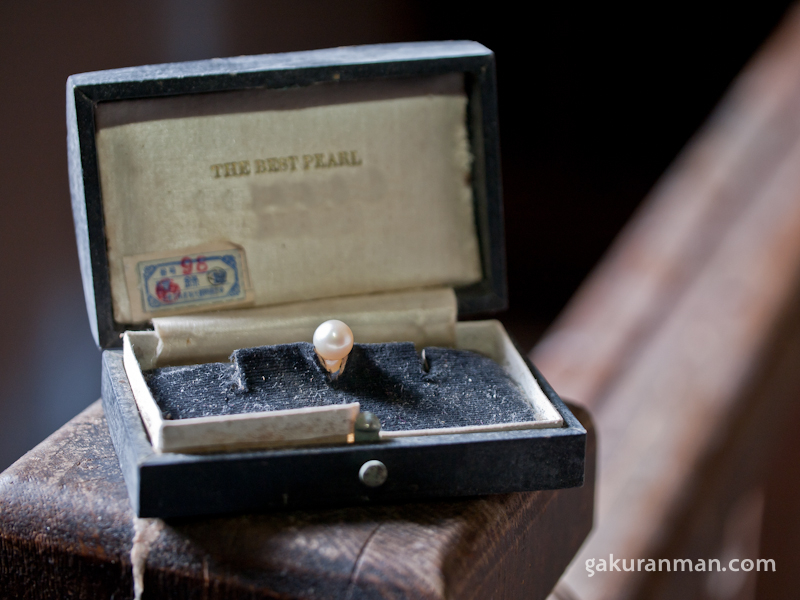
(Above: A lone pearl found in the house. It appears to have been broken off another piece of jewellery.)
Respecting the Past
When I first visited this house, I treated it much the same as any other haikyo. It was an abandoned building hidden in a mountain forest that happened to be so well concealed that it was virtually untouched. When I arrived at the house recently for my third and final time, I found it in a far worse state than before. My fears had been proved correct and the recent exposure of the location has directly led to the state of disarray the rooms were now in. I’ve said many times when writing about haikyo that I do not give out locations for this very reason. Japan is a relatively tame country for Urban Exploration in that explorers generally respect locations and the items inside far more than I’ve seen in most U.K ruins. It is much safer to visit them and people are friendly. But even here, it seems some people do not respect the property.
Photos were strewn all over the floor of the back room, bags emptied out and draws left hanging wide open. The black box containing scrolls and other items were left in a mess by the side of it, as if somebody had left in the middle of looking through the old materials. We couldn’t believe it. It hardly takes a lot of time to put the photos back and keep the place as it was found. Fortunately, the main room and photos were still intact and no damage has been done. After we’d finished looking through the last of the documents, we tidied the rooms up and put things back to how we first found them. I doubt it will last long, but I couldn’t stand seeing the place in such a state.
Some of you have also questioned me in the comments about the issues involved in exploring such a building. I have the utmost respect for the family and their past. This haikyo has taken me by surprise in its unusual nature, the links to royalty and deep family history. It took a hold of me, even pushing me to order books from the U.K and visit the temple where the family was buried in order to learn more about their history.
Is this an invasion of personal privacy? Doesn’t the house still have an owner who would be angry? Arguably this could be true. I cannot be completely sure that all remaining relatives have passed away, but to the best of my knowledge they have. There are also ethical issues about posting information about people who are deceased. Should I also not report the location to a local historical society? After understanding more about the family, I am not sure that is the right thing to do, or that it would help in any way. As well-off as this family was, they don’t appear to have any blood ties to royalty or a place in a museum. Nor can I be sure that is what they would have wanted any more than I can be sure of this post. But I feel I should do something… Perhaps it is a discussion that should be had on 2ch and other messageboards..?
I am not a relative or even a person of worthy standing to be documenting their life, but merely a curious explorer who has become entwined in this family tale. I of course have feelings of guilt and frequently face the moral dilemmas involved with such a hobby, but I bear them in the knowledge that I do not harbour any malicious intent. I am careful in what I choose to expose and react to the situation as best I can. Although this hardly absolves me of my responsibility, perhaps it can go some way to explaining my desire to write and research about this small portion of history.
When I step back and think about the whole experience, I feel I perhaps may have done a little bit of good in talking about the family. The K family existed. John had a life in Tokyo with wonderful people that was never even expressed in the official book about him. The family had numerous business connections abroad, including trading pearls with India. Junji loved cats and honoured their passing with a place on the Buddhist altar.
These people mattered and deserve to be remembered. If I have contributed to that even in just a small way, I will feel happy.
**********
I will continue to update this article with information and facts as they become available and also welcome your honest comments below. It’s been quite a ride but in some ways considerably more satisfying than a simple haikyo exploration. I’d like to thank all the other bloggers who have contributed to the research so far and to the team on 2ch, whose analytical skills never cease to amaze me. I hope the K family and their relatives are resting in peace. Thank you for reading.









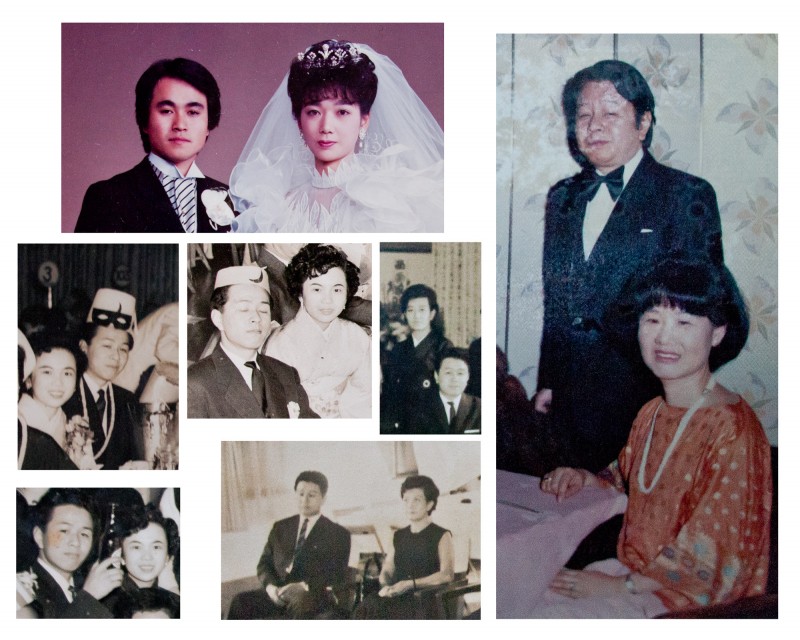
Hello! all right? I wonder if any of the museums weren’t interested about the history of this family of royalty in preserving the family objects as souvenirs or if you have tried to show this material to a museum or collector. I feel like if I leave things there can be lost, stolen or vandalized it becomes so sad for this family history. Thanks
This has been a truly fascinating and all too tragic adventure…my thanks and congratulations to you. My curiousity about Mr J was so great that I went looking for more information and came across the blog from Jordy Meow which finally tied up the loose ends for me…
Jordy’s blog ended with a number of people saying that they had ‘just been passing by’ and how sad they were that the place has now been vandalised… So a question…in hindsight, could you not have documented everuthing exactly the way that you have BUT without sharing any part of your discoveries? They say that if, on your travels, you come across an untouched paradise…the best thing to do is not to tell anyone about it…
Thanks for the comment!
That’s one of the fundamental problems with any pursuit that involves journalism or documentation of some kind. The exposure from publication comes with unwanted consequences. However, to avoid publication defeats the very purpose of these pursuits, which is to bring light to areas not fully understood.
For urban exploration, it’s often the case that people who put the work into finding a location from piecing together clues have a lot more respect for the place and do not vandalise. For a good few months or so after I published my first article about the Royal House, the Japanese 2ch message boards were buzzing with theories about the family and had lots amateur detective work. Nobody was able to find the location until somebody came along and posted a map. That immediately led to its downfall.
I suppose I could just enjoy my adventures and keep the stories to myself. But I would be less motivated to push my limits to improve, and I would miss the joy of telling a good tale to an audience. This website would cease to exist and I think (or at least hope!) that we’d all be a little worse off as a result. That’s not to mention that somebody else will eventually find the same location. No paradise is untouched forever – it’s just a matter of time.
The only realistic way to prevent these sites succumbing to vandalism is to have them looked after. In the vast majority of cases, the locations simply aren’t worth the effort or money to do so, and they will eventually collapse anyway. So we’re really having a discussion about how long a place has left until nature takes its course. The best I can do is limit the amount of information I give out to extend this natural lifespan. Every time I write a new story, I think about exactly what details and how much information is safe to show, while conferring with other explorers. This allows me to keep writing and sharing pictures, and makes it hard for the vandals.
I hope that gives you some insight into the thought that goes into these articles when I write. It’s a never-ending struggle that we explorers have to deal with!
I am mostly sure that the child sitting in the forefront of the cut out photo is Kiyoko. Her face looks similar to the face of the young smiling woman that we seen on the other photos.
When I’m daydreaming about abandoned places, I always regret to not known the history and the names of the people who once inhabited them. Thanks to you, I can put names on all these portraits.
I really appreciate your work and your innate respect for old things. Too many people are considering that ancient belongings are good enough to the bin. They esteem that modernity must necessarily overlook the past,without more looking back. I’ve always find it sad.
I’ll certainly keep an eye on your stories. They are fascinating, I really got the feeling I’m travelling and exploring those sites by myself !
Hi! I’ve just spent an hour here after following a link from a page about virtual haikyo (in ‘Second Life and such like).
I’ve skimmed through the comments and I don’t think anyone has mentioned this yet: I reckon the date on the back of the photo suspected to be of Kiyomi-san is not 13th but 23rd August. That looks like the character for 20, as in Hatsukaichi/廿日市 in Hiroshima-ken. Still, I don’t suppose that makes much difference to your explorations.
You would be interested to know that I work for a dance charity in the UK. Mr J’s foundation provides us with invaluable grants to allow us to keep doing what we are doing and is a major player in keeping British arts alive.
You can imagine my excitement about finding out his name after reading all the parts of your findings.
Update on the J Foundation’s success (the family names have been published now on the Metropolis Magazine’s haikyo page): http://www.independent.co.uk/news/people/profiles/alan-grieve-is-the-future-of-the-arts-in-his-hands-a-serial-giver-owns-up-7554164.html
This actually made me cry. I felt both joy at finally knowing who this family was and sadness at how they seem to have abandoned their beautiful home. I hope you can find out more and give real closure to this story. And you ARE someone important, anyone who follows their curiosity is someone important. ^^
Very well-written story, well-detailed, to the very end. Thank you for sharing. You mention early in the posting that the unwritten rule re. haikyo is to never post any information about map references or exact locations. I’m an abandoned house exporer..have been so since teenage times in France…great old castles and abandoned farm houses and such there, and since I’ve been in Japan it was only natural that I’d check out such kinds of structures. I started off with old, abandoned thatch roofed houses in Chiba Prefecture, and moved out from there.These are veritable time machines revealing much about the way of life of Japanese of yesteryears.
Just came across your website and this haikyo page. It is the most interesting and well written piece on a haikyo property. Much of stuff on 28 days later in the UK seem to concentrate on the quality of the photography – and many Japanese haikyo pages often has a “ghost” or “spiritistic” element which I don’t like. An absolutely fascinating read. Thanks!
Thanks for the comment! Glad to know that my stories read well. I started out just focusing on the photography myself, but quickly grew unsatisfied with how cut and dry it made these places look. I try to strike a balance between tales of exploration, beautiful photography and historical research and accuracy.
I don’t usually read about haikyo, but I couldn’t stop reading this story about the Royal House. Thank you so much for doing all this research and exploration work, and giving us a glimpse of this family’s life. As someone whose older family experienced a similar fate, from luxury to almost poverty, I can only hope that all the members of the K. family are resting in peace, and whoever is still alive, if anyone, remembers them fondly.
Thanks for the comment :). This tale still hasn’t been completely solved, although I have made some progress with new information. If it ever comes together, I’ll write a follow-up post.
Oh, please do!
I am waiting your new facts. If you need my idea, please let me know.
Will do! As soon as I can get things organised :).
Suggest you title, or subtitle, this fascinating documentary “A Family Reconstructed”…
As it is only a matter of time before all is lost to fire, water, or vandals, and given the unlikelyhood of there being a living youngest sibling, I really wish you would do a full documentation of all the documents and photos. There are many more stories to be told here.
Also, are last wills and testaments filed in Tokyo as they are in the USA? If so, maybe it would be useful to the details of the story to find the wills of John and the rest of the family.
I also recommend you do this before the old priest passes on, as you might want to do another follow up with him.
I would still like to understand the missing person in the pic… Unless the removed portion of the photo went into a locket or the like, to cut a person out of a pic represents extreme hate… Even if the same person was in some pics and cut out of others, this could be due to the pics belonging to two different people, and the cutter respecting the other person’s ownership of the pics by not cutting them despite hatred for the person removed from their own pics.
Thanks for sharing your thoughts. I’ve done some post research into this place and discovered a few extra details, but short of trying to make direct contact with the living relative, it will be a difficult one to solve. Some good ideas on why the person may have been cut out of the photos though. Cheers :).
Hi, Micheal, I am waiting for the final conclusion. I suppose there must be big surprises for me.
Sugiko.
Hi,
I have got registration documents from Minato-Houmukyoku( Minato registration office under ministry of Law) for thier old house closed to the Hotel Okura, where Nigeria Embassy is located now. It is tough for me to understand. Because there are a lot of Law terms.
I also contacted with Lee Chapman. Give me some days.
Hey,
I too “stumbled” onto your site, knowing nothing about Haikyo, but have burned a good couple of hours reading about all of your explorations. The story of the ‘Royal Family’ is particularly fantastic as you have managed to find out so much background information! I can only congratulate you, and I look forward to reading about all of your future ‘urbex’s.
Alice.
Fascinating. Good on you for all this work you are doing.
Thanks :). Glad you enjoyed it!
Hi Michael I stumbled onto your site by accident today and this exploration has held me to the screen for at least 3 Hrs reading all about the house and the research that you have gone to,at one point you mention should you contact a local authority/historical society in my mind you should do this because as far as i know the Japanese regard their history very highly. I mean there seems to be connections to the Japanese emporer and the British royal family these moments in time should be recorded for prosperity by local historians,and all items from the house should be removed and taken to a local museum for safekeeping where their deterioration can be halted. As to the work you have done here you should be commended for this for the time and effort you have taken to gather all the facts so far ( here’s hoping some more turn up ) all i can say now is thankyou for an interesting read and look into a place i will never get to. Thanks George..
Hi George,
Thanks for the comment! As far as I’m aware, somebody on 2ch said they’d notified the authorities, and I know a friend of mine contacted the Association with whom Mr. J was linked to, but they were not interested. It seems to be just a house, albeit with a wealthy connection. I’m not quite sure it would merit a place in a museum, but it is certainly an interesting place. Fortunately at least some of the history is captured here.
This is an incredible tale and investigation! You’ve done a wonderful job of documenting this haikyo and piecing together the clues about its history. Thanks for sharing!
Glad you enjoyed it!
I stumbled onto this article after trying to research haikyo pictures for inspiration of a drawing. I was very moved by your respect for this family that you don’t know personally. The article was very interesting, they seemed to have a colourful history. I’m glad you shared this with us, though it saddens me about the people who made the location public. I hope nothing is stolen or ruined in the house.
Maybe one day I will find this article again and the mysterious fog surrounding the family will have lifted a little.
Thanks for dropping by. I hope one day the full mystery will be solved, but for now it seems the trail has dried up…
Interested in seeing you haikyo picture once it’s completed! :)
Any new development on this?
Although I have been in that region when I went to Japan last month, I didn’t have time to pass by this place and see it for myself. I’ve searched over the Internet but found no new information about it so I guess nobody made further research or have put it on the Internet yet…
ミッチ
I realize this is old news, but it’s a fascinating story, and I’m especially interested in the circumstances surrounding the person cut out of the photo. I tried to think about what the whole human drama behind this story could be, and came up with a few fun (if a little sad) thoughts about it.
So it appears that all of John’s money was meant to be donated to the Foundation after he died…I doubt that Sugiko would have been left not taken care of (but maybe that’s some additional missing documentation hidden or lost somewhere pertaining to John’s estate?)…or would she have been? As I looked over and over again at the photos, I couldn’t help but notice what a sourpuss her older sister appeared to be. Would it have been possible that John maybe meant to leave his wife’s siblings penniless once he died? Perhaps when he married Sugiko, he became resentful, but turned a blind eye to the fact that she was spending the allowance he gave her on her siblings – particularly an older sister. Maybe he thought of them as parasitic, especially since I don’t think it was all that common in Western culture even back then for a married couple to be taking care of siblings. Kuwa would have been a different thing since she was Sugiko’s mother. Since the older sister outlived Sugiko, could it be possible that out of bitterness (if that happens to have been John in the photo) SHE might have cut him out of that picture?
I wish we had more information about how the family got along. Have you or anyone ever gotten any clues as to whether or not there might have been any discord in the family? I’m guessing there must have been somewhere! How many families don’t have a little drama somewhere, you know? :) Anyway, just a little daydreaming about what the lives of this family would have been like. It does seem really mysterious that John would have been so strict about having all of his money sent to the Foundation and none set aside for at least his wife! Maybe there are some shocking things about John’s personality that would really lend some insight to the whole story! For instance, if they had a house in Tokyo near the hotel, why on earth would the sisters have been living in the hotel and not the house? That seems really strange to me. Also, if John was so rich, wouldn’t he have been able to build and pay for that little house all in one go? Would someone still have been making payments on the thing after so many years?
You’ve been doing such great work on this story, I really hope you can find out more about this family! What kind of a man was this John, and was he a stingy miser who merely took Sugiko as a token to bring himself closer to business with Junji? It sounds like Junji was a very important and influential man, and it wouldn’t be the first time in the world that people were used and discarded to further a business venture. Even stranger that they didn’t have any children. I wonder what Sugiko’s parents made of that, since it’s so important in Japanese culture to shoot out the babies as soon as possible once a couple is married here. I wonder if it was a choice they made.
I also wonder what has become of the youngest sister. Could she have escaped that family when she got married, and purposely estranged herself from them?
Had she warm memories of that little house, my guess is that she would have wanted to try to maintain it, particularly since there were no other descendants to claim it for themselves. I wonder if she has anything to do with it. I really do hope someone contacts her at least to let her know that people have been rifling through the house – especially now that someone has made the map public…I hate to think what’s become of the house now…
Anyway, just my daydreaming about the family. Lots of guessing – I hope someday we have some answers and that maybe that house becomes preserved or protected before vandals come along and steal those precious historical artifacts! Thank you so much for all of your hard work!
This comment uses the machine translation.
Hello.
The person who exists in the newspaper clipping is not Mr.Junji .
Kintaro Shimizu (1889-1932) is the vocalist from end of the Meiji era to at the beginning of the Showa era.
He was taking an active part in the stage that translated the opera in the foreign country into Japanese and performed it (that was called “Asakusa opera” in the Taishou era period).
http://ja.wikipedia.org/wiki/%E6%B8%85%E6%B0%B4%E9%87%91%E5%A4%AA%E9%83%8E
His grandchild is acting as a musician in Japan now.
http://ja.wikipedia.org/wiki/ACE_(%E3%83%9F%E3%83%A5%E3%83%BC%E3%82%B8%E3%82%B7%E3%83%A3%E3%83%B3)
though the reason with the clipping is uncertain, I think that there was some relation to which Torinosuke was doing work the movie in Asakusa.
Wow… I was just looking for interesting haikyo to explore during Golden Week, and I happened across your site and this story.
Excellent writeup and investigation! Thank you for stealing my time and attention :)
It also didn’t occur to me to check out haikyo info on 2ch… I’ll go check it out.
This is a pretty awesome site…I wish I could of let you in on some of the caves and forgotten things on the military bases when I lived out there…One of the neater things I found was a rifle rack with what looked to be the remnants of old socks hanging over them, and some old WW2 Japanese boots next to the rack as well.
Great work, Michael! I’m a little late I know, but have only lately read about this great Haikyo on Jordy’s page and then came here to read your part. What a story! One of the final mysteries about it, in my personal opinion, is what Kaede-san discovered in the library. Do you think it’s the fact that Kiyomi may have had to live in poverty the last years of her life? This is a theory that John’s last will does support, but did you find evidence that she was actually living somewhere else than in the Okura Hotel? Did you see if there was a sender’s address on her stuff that was obviously delivered there after her death when the house had already long been abandoned? Or were there any photos showing her presumably after Sugiko’s passing?
gracias por tu excelente investigacion amigo.. encantado ;-)
Amazing! I am an active urbexer in Sydney and a member of Australia’s longest established urbex group. I lived in Japan for many years and have explored a fair bit there, particularly around Yamanashi. I have never cme across anything quite like this before. The effort you have gone to to document this place is a great credit to you. I come to Japan about once a year and I am looking for someone to explore with. Drop me a line if interested, or if you are coming down under and are looking to do some expolring. [email protected]
If this doesn’t make me try out haikyo, then I don’t know what will.
Best of luck if you do! Stay safe.
OK, so the about the names being different in print, I was wondering just to clear this point up, could one perhaps have been a preferred and the other official usage due to historical exclusion from the toyo/jinmeiyo lists for print (and politics, can’t forget why 「璽」 is still kicking about in schools!). As it stands there are a fair few versions of this character: mild differences in the stroke angle on stroke one and corresponding vertical placement of two, changes to the second element on the left side, wholesale replacement of that righthand radical.
Ok, so after some fishing about online:
「鶏」 is, of course, Joyo jisted, so can be used officially. 「鷄」 is Jinmeiyo listed (note the first two changes noted above) as an alternate official grapheme for use in names. 「雞」 isn’t in either so is strictly unofficial: heck, Japanese Wikitionary doesn’t even have a listing for version above so I doubt it’s even a “common” unlisted, although it is noted as an alternate grapheme for 「鶏」.
Put it this way, if I personally were in the hypothetical situation where my name used an outdated kanji and had the choice of how I wrote my name, I’m a bit of an old-fashioned guy, so I’d register it up and write it as told when needed, but I’d rebelliously put my preferred traditional way on a businesscard regardless. That’s my personal logic at least, but I doubt I’m alone in my thinking…
I’d conclude the two names are the same and wouldn’t worry so much.
* * *
I’m amazed at how much has been discovered about this ruin. Sigh, makes me miss being in Japan (I think I even recognise that cemetary as being near my old work) – I still had so many more haikyo I wished to visit before I left and didn’t find the time. I found the experience of living in a society where history around is right there but being forgotten faster than interested parties could pick up the pieces utterly fascinating. There was something vaguely poetic about the idea, like a child trying to catch all the autumn leaves from a single tree in the breeze. Urbex elsewhere seems to far away, more catchers, fewer trees, no breeze.
This one seems to me a prinstine leaf, one worth catching indeed.
Amazing job, and I truly wish all ubexers had the same level of respect you do.
Thanks for the insightful comments Paul! After reading your thoughts on name usage, I’m more inclined to believe it might be the same person. Cheers.
Awesome analogy of the falling leaf by the way. I haven’t done a lot of urbex abroad (even in the U.K), but the few that I did explore were shells of their former selves. Most had been completely trashed and nearly everything stolen, including lead from the pipes and other metals ripped out of the building itself!
I don’t know how any haikyo is going to top this one, but I said the same thing about Gunkanjima last year, and look what happened! Here’s to another great year of exploration! :D
Hello Michael,
I just want to share my respect and thanks for your series of articles. Having never been to Japan only knowing of the culture via American history books, I greatly appreciate the insight, passion and perseverance you have shown and provided. Thank you.
Thanks. Glad the story provided some background to Japan and its culture. But this is only barely scraping the surface! ;)
I’m sorry I have to disagree here :p I don’t think that guy is married to Kiyoko. I think he works for Okura Hotel and that’s why we could find the photo in which he’s praying in front of the tomb INSIDE the house (otherwise how it could be found there ?). Also, on the wedding picture, I think the girl is not looking like Kiyoko (but the guy, yeah maybe he’s the same Okura Hotel’s one). This girl/woman is a real mystery, she’s not appearing that much on the family pictures, and I guess her life was somewhere else. She doesn’t seem to have written many postcards to the K. in the house neither. There must be an explanation…
Haha :p. But if he does work for Okura, why is he *always* with the same woman and why is he sitting down invovled in the parties? A member of staff would not do that unless they took time off, but even then, what evidence is there showing he is a member of Okura Hotel staff?
The photo of him inside the house – I’m not sure what you mean? All the photos of him were inside the house. The family grave existed before Sugiko and John passed away.
As for the wedding picture, I’m a little less sure. The resemblance seems to be there, especially in him. The woman less so, but judging by the man’s face matching the guy in other photos, it seems sensible to match the woman as well. But yea, the wedding photo resembles them the least. However, in the photo on the right, the woman is wearing a ring and the guy is the same (same smile, squint). So even without the wedding photo, this couple appears together in nearly every photo I have that involves a party or a funeral. I find it a little hard to imagine he is just a member of staff… Hmm…
Wow! I’m a fan of urban exploration photography and recently stumbled on your blog and your haikyo photographs. I’ve been following the “Royal House” story with interest. How great that you were able to track down the family temple and talk to the priests who knew the family. I’m glad there is an end (of sorts) to the mystery — but it’s a real shame that some people have apparently not been able to respect the house the way you have. :(
Thanks Tina. It disappoints me as well that certain people can’t even keep the place tidy :(. I really hope that future visitors be respectful after we tided things up again.
I feel that you have indeed done good work over the course of your exploration and research. I agree that those of us who have been following your posts will remember this family and what we now know of their lives–we do them honor by remembering. I frankly think it’s a good feeling to recognize and remember another’s life, even more so when it’s someone you never knew.
I’m glad people feel that way :). The research is still far from complete (I doubt it might ever be unless a definitive record is found), but even in the half-finished state it is now, I’m happy we were able to find out some background to the family John married into.
Hello Michael,
I’ve been following this exploration of yours with great interest! I’m very happy to see how much respect you show for the family and their belongings, and I was very disappointed that the location has been made public by someone else.
I hope some day you will fully unravel the mysteries surrounding this haikyo and share it with us!
Regards,
John
Thanks John. I hope more information comes out in the future. If it does so, I’ll certainly try to add it to this article :)
Well, with this majestic relic of the past like you call it, I guess we cannot, as urban explorers, go further more into the history and details of who owns the place. I personally think we could but there might be some privacy concerns about this, I’m not sure what Mrs. N would think about it if asked for.
Nonetheless, I gladly thank you and congratulate you on respecting the past, in this particular case, with such investigation which has gone really beyond what we could have done with other haikyos.
What did you meant when you wrote that the place was in worse state than before? Did the walls shattered? The roof collapsed? Artefacts went missing? Somebody stole important, unvaluable stuff? That is unforgivable. At that point, a major concern would have been that a former investigation takes place from local authorities, but again…
Well, I didn’t happen to run into the forum or the “2ch” website you’re talking about but that may have already been a subject of discussion in a matter of protecting the cultural, historical or actual mystifying value of this specific haikyo. Also, I wonder what Kaede-san actually discovered that let her to think they have found something that they shouldn’t have got into. Since the website no longer feature this kaikyo and the point of vue that she specifically had, maybe it’s another thing to be resolved.
By the way, even if at some point I wish I would have got the information, I strongly disapprove of people leaking the location of this important relic of the past simply because it can’t be helped… GOSH!!! WHY?
Now, SADLY, the clock is ticking….
Even if I did not got into any involvement regarding this story, I followed it thru, in silence, since the very beginning, but now I’m about to shed tears…
Someday, when I’ll go to Japan, I’d like to know at least the temple where those people are buried to pay respect for them at their grave.
Cheers..
mitch aka isuna (( http://www.isuna.tk ))
Thanks for the comment.
When we visited the house again recently, all the photos and documents were scattered around the room and on the floor. As far as I could tell, nothing was broken or stolen, but just a lot messier. The place had lost some of its charm for the state and I worry it was just the first step down the road to the ultimate demise of the house. We tidied things back up as best we could, but now that the location is out I don’t know what will happen…
great post! can’t wait for the next part.
Cheers!
Thanks Charles. I’m not sure there will be a next part though! I wrote this one with the intention of wrapping things up. I will keep adding stuff to this post as it is confirmed though, so keep an eye on twitter for small updates if you are interested :).
good thing i noticed there’s an update. i’ve been following this story since your first post.
anyway, how about communicating with John’s relatives? maybe they have some story to tell.
I’m not sure John has any relatives… I suppose contacting the Foundation is a possibility, but since this house was not John’s (or registered in his name, from the looks of things), I’m not sure the Foundation would even care about it :(.
John’s father died the year he was born , he does have a half brother called Robin Fawcett
Wow, this is cool. To be brutally honest, I’ve never had much more than a passing interest in haikyo and not paid much attention to these posts, but after reading this, I’m now very interested to go back and read through the preceding posts and your other blogs on the subject. I’ve done a lot of genealogical research in my own family in the past and enjoy the “mystery” aspect of it, even though that process is nearly always document based. This has great personal and physical aspects that are really fascinating.
I guess with the increase in childless couples, these kinds of places and their mysteries will grow in future.
Great read, good job man.
Peace
Hey Hiko. Thanks for dropping by. I’m glad I managed to hook you enough to become interested :p The charm of haikyo is different for everyone, so I understand lack of interest perfectly well. Delving into the back story and actually doing some investigative work has been a new experience for me and quite rewarding too. I’ve also learned a thing or two about how to properly store photos so they don’t rot and most importantly, to write names and dates on them! This whole process would be so much easier with the odd name on the back of a photo :p.
Indeed, although you have to wonder as well, with everything being digital nowadays, how much data will be lost. I guess the Haikyo of 50 years from now will have old computers in them with rusty hard disks… The end of film and photo momentos will be another challenge for ensuring family histories and records can continue to be passed down.
That’ll be tricky. The same goes for documents too as people print less and less. It might make houses very impersonal places if everything ends up digital…
You are right, most photography post the digital camera and smartphone era will simply not exist for all practical purposes. I find our family albums from the 1970’s through the late 1990’s a pleasure. The thousands of digital photos scattered across hard drives , web sites, and phones is hopeless!
nice work on the mystery. i am finding this all very interesting. i appreciate your respect for the family and the manner in which you are ‘exploring’.
Cheers :)
Thank you for sharing all of this! It’s great that you’ve been able to build the window for us to look through and catch an amazing glimpse of the past.
Thanks Leyla. Glad you enjoyed it :)
Finally you decided not to sleep right?! Wow! Okay, that was a quick reaction and now… I have to read ;)
Haha, I was up pretty late, yea x_x. Speed is everything with this one. The rate the guys on the forum are going, things will be solved pretty soon!
I just finished reading! Really good, everything is extremely well sum-up. I guess it’s always possible to find more and more information based on all the pictures of postcards, letters and others but… I think we both did a nice job at respecting the place and its owners by solving this in rather a positive commemorative way. Much better that those guys who messed-up everything upstairs or… those who get naked in order to get the oddest shots possible! Anyway ;) There is something I’d like to add though: let’s not recall this place as a ruin, but as a relic of the past, a majestic one!
A majestic relic of the past indeed :). I do hope it comes across as a commemorative piece and that future explorers respect it more than those few who scattered stuff everywhere. I’m still looking forward to see what other information comes out on the forums though! The father figure and the mysterious hole in the photograph make me very curious ^^;.